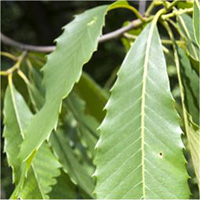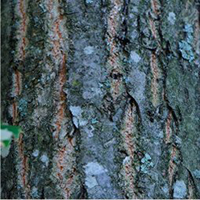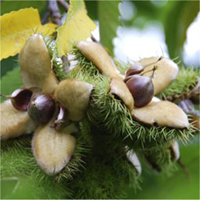American chestnut
Scientific name: Castanea dentata




“Endangered” means the species lives in the wild in Ontario but is facing imminent extinction or extirpation.
Cover photos credit: Tree: Joseph O'Brien, USDA; Leaf: Natural Resources Canada, Canadian Forest Service; Bark: Vern Wilkins; and Fruit: Melissa Spearing.
Date added to the Species at Risk in Ontario List
The American Chestnut was already assessed as endangered when the Endangered Species Act took effect in 2008.
What it looks like
The American Chestnut is a tall deciduous tree that formerly reached about 30 metres in height; however, trees in Ontario are now typically only five to 10 metres tall. The bark is dark grey-brown and cracks with age.
Leaves are mostly hairless, 15 to 30 centimetres long and five to 10 centimetres wide at maturity, with coarsely and sharply serrated edges and a long pointed tip. Chestnut trees have both male and female flowers but cannot self pollinate. The fruit is a spiny bur-like husk enclosing one to five edible nuts. Small mammals and birds distribute, store and bury the nuts.
Where it lives
The American Chestnut prefers dryer upland deciduous forests with sandy, acidic to neutral soils.
In Ontario, it is only found in the Carolinian Zone between Lake Erie and Lake Huron.
The species grows alongside Red Oak, Black Cherry, Sugar Maple, American Beech and other deciduous tree species.
Where it’s been found in Ontario
The American Chestnut has almost disappeared from eastern North America due to an epidemic caused by a fungal disease called the chestnut blight (Cryphonectria parasitica).
In Canada, the American Chestnut is restricted primarily to southwestern Ontario.
Based on information available in 2004, it was estimated that there are 120 to 150 mature trees and 1,000 or more small, young trees in the province.
View a Larger version of this map (PDF)
What threatens it
Chestnut blight has had a devastating impact on the American Chestnut. The accidental introduction of this fungus to North America from Asia in the early 1900s killed 99 per cent of American Chestnut trees within about 30 years.
This disease continues to be the overwhelming threat to American Chestnut throughout its range. There is no proven natural resistance to the disease found in the remaining population.
Fortunately, the disease primarily kills the top of the tree, often leaving living root systems. Diseased trees respond by re-sprouting from the base of the dead stumps.
The existing population primarily persists as saplings and trees that grow from these stumps and the odd tree that germinates from viable seeds. Habitat loss due to forest clearing and damage to trees during logging operations are additional threats.
Action we are taking
Endangered Species and their general habitat are automatically protected
Recovery strategy
A recovery strategy advises the ministry on ways to ensure healthy numbers of the species return to Ontario.
Read the executive summary (June 15, 2012)
Read the recovery strategy (June 15, 2012)
Government response statement
A government response statement outlines the actions the government intends to take or support to help recover the species.
Read the government response statement (May 31, 2013)
Five-year review of progress
A five-year review of progress made toward protecting and recovering a species is required no later than five years after the government response statement for that species is published.
Read the report on progress towards the protection and recovery of 17 species at risk, including the American Chestnut (2018).
Habitat protection
General Habitat Protection - June 30, 2013
What you can do
Report a sighting
- Report a sighting of an endangered animal or plant to the Natural Heritage Information Centre. Photographs with specific locations or mapping coordinates are always helpful.
Volunteer
- Volunteer with your local nature club or provincial park to participate in surveys or stewardship work focused on species at risk.
Be a good steward
- Private land owners have a very important role to play in species recovery. If you find American Chestnut on your land, you may be eligible for stewardship programs that support the protection and recovery of species at risk and their habitats.
- Pollinators, such as bees, are in steep decline across the globe and they play a key role in the survival of many of Ontario’s rare plants. For information on how you can help scientists monitor pollinator populations in Ontario visit:
www.seeds.ca/proj/poll. - Invasive species seriously threaten many of Ontario’s species at risk. To learn what you can do to help reduce the threat of invasive species, visit:
www.ontario.ca/invasivespecies
www.invadingspecies.com
www.ontarioinvasiveplants.ca - The Canadian Chestnut Council is a scientific and charitable organization dedicated to the protection and recovery of American Chestnut in southern Ontario. Find out more about this organization at www.canadianchestnutcouncil.ca
Report illegal activity
- Report any illegal activity related to plants and wildlife to
1-877-TIP-SMNR (847-7667)
Quick facts
- When they were abundant, the edible American Chestnuts provided an important source of food for a variety of animals and birds, as well as people.
- Aboriginal people used the American Chestnut for treating numerous ailments (from coughs and dermatitis to heart trouble), as a staple food and beverage, to build shelters, for firewood and as a source of dye. Early settlers soon realized the many important uses of this tree.
- American Chestnut flowers are pollinated by insects. Squirrels scatter and plant the seeds when they bury them.
- Don’t confuse the rare American Chestnut with the cultivated chestnuts found in Ontario. These include Spanish Chestnut (C. sativa), Chinese Chestnut (C. mollissima) and Japanese Chestnut (C. crenata). All of them have varying degrees of hairiness on the lower leaf surfaces. Hybrids between these species and American Chestnut are known and difficult to identify.
- Horsechestnut (Aesculus hippocastanum), is a very different tree planted in urban areas of southern Ontario. It has five leaves in a semi-circle formation and a spiny fruit containing one large shiny nut.
